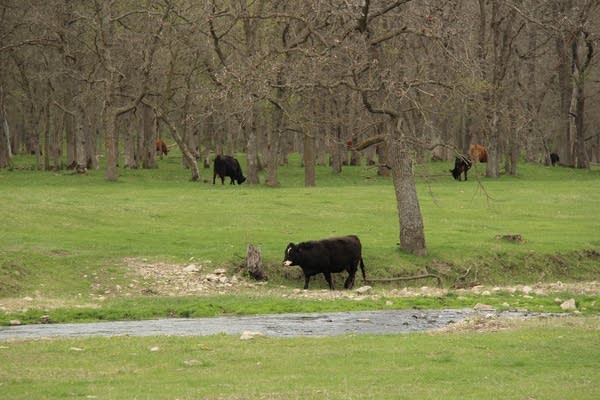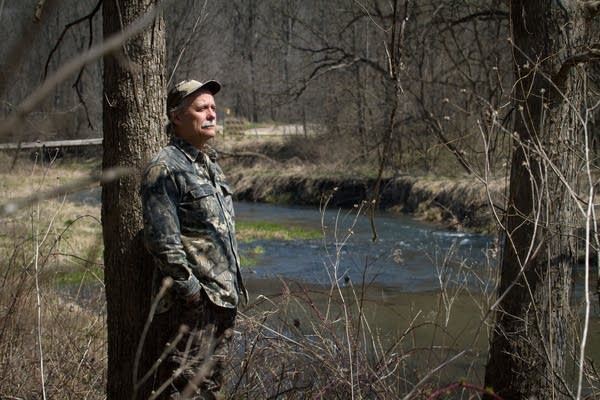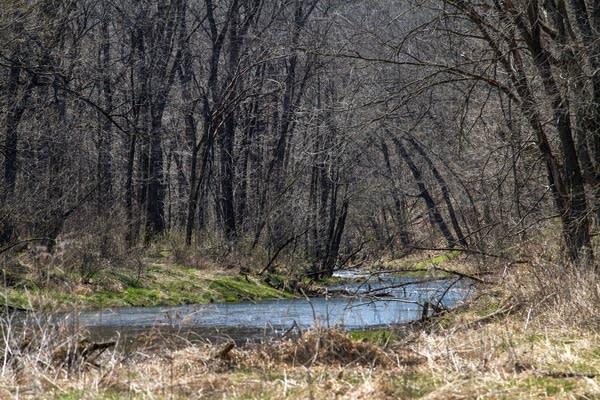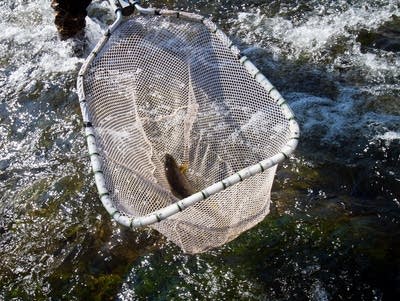Trouble in the water: Can Minnesota stop polluting its lakes, rivers?

Jeff Broberg had long agonized about the health of the Whitewater River. But when 10,000 fish died suddenly and inexplicably in the river last summer after heavy rains, alarms went off.

The Whitewater, southeastern Minnesota's iconic trout stream, is known nationally for its pristine beauty and fishing. Yet the rains had turned it, temporarily, into a kill zone.
An environmental consultant who fishes the river, Broberg worried farm pollution could strip the Whitewater of its trout. State officials failed to identify a specific cause for last summer's fish kill and instead suggested that a mix of "biological, chemical and environmental conditions" could have been to blame.
Broberg believes what happened on the Whitewater should set off alarms across Minnesota. Regulators, he said, are not protecting water from increasing farm threats.
Create a More Connected Minnesota
MPR News is your trusted resource for the news you need. With your support, MPR News brings accessible, courageous journalism and authentic conversation to everyone - free of paywalls and barriers. Your gift makes a difference.
"This is a dramatic example because it's clean water. It's a trout stream," he said. "I really fear that we've gotten to the point now where the industrialization of the agricultural process is just taking over the entire ecology."
For Broberg and others, the massive fish kill on the Whitewater was the latest sign of serious, widespread trouble in Minnesota's waters. Some 40 percent of the lakes and streams are polluted, with much of that centered in southern Minnesota's farm country. In six far southwestern Minnesota counties there are no lakes considered fishable and swimmable.

At the Capitol, lawmakers are divided on how far to go to fix the problems. Gov. Mark Dayton has made water quality an issue central to his legacy. He's pushed to boost the number of buffer strips along Minnesota lakes and rivers to help trap farm runoff, although he stepped back from some of those efforts amid pressure from some lawmakers and farm groups.
Farming isn't the only pollution source, but there's no disputing the correlation between farming and water pollution, said Minnesota Pollution Control Agency Spokesperson Cathy Rofshus.
"Water quality is usually exceptionally high in the northeast part of the state and tends to degrade as you go to the south, [and] southwest," she said.

Here in southeastern Minnesota, about 45 minutes from Rochester, farming and water quality are regular topics for debate.
"You can sense the tension, I guess, in the air," said Vaughn Snook, who helps manage southeastern Minnesota's fishery for the state Department of Natural Resources.
More people than ever have been calling his office with water quality concerns, he said. "'Why is that truck there? What's this doing?' They don't have blinders on when they drive down the road anymore," Snook said as he walked along the south branch of the Whitewater on a recent day while brown trout feasted on a spring caddisfly hatch.
"They're kind of looking around," he added, "curious to know why somebody's parked somewhere and there's a pipe going into the creek."

The Whitewater ran crystal clear on this day and Snook saw trout, white suckers and other signs the river was recovering from the fish kill.
Still, when it rains whatever is on the fields above — manure, chemicals, soil — can easily make its way into these waters. A mile or so upstream, cows graze along the Whitewater. They also defecate on the river bank.
"If we were to come back here when we had a 2-inch rainfall, this water would not be clear. It certainly would be off-color if not even muddy," Snook said. "It just depends on where the rain fell and what had recently happened up top."
The MPCA has found several common pollutants in the river, including fecal coliform bacteria and nitrate, which can cause health problems for pregnant women and infants.
Statewide, the Minnesota Department of Health has detected nitrate pollution in more than 8,000 new drinking water wells. More than 1,000 had nitrate levels deemed unsafe for infants and pregnant women.
The Minnesota Department of Agriculture is trying to test as many as 70,000 rural wells for nitrate by 2019. Preliminary results found one in 10 unsafe. State Agriculture Commissioner Dave Frederickson calls that distressing, but not surprising.

"In some of the more intensely cropped acres in Minnesota we're seeing nitrate levels two, three and four times the drinking water standard which is 10 parts per million," he said. "We're seeing up to 40 parts maybe even as high as 50 parts per million."
The MPCA is examining all 80 major watersheds in Minnesota one-by-one to document water quality. Regulators used to study only water with known problems, said agency pollution control specialist Shaina Keseley. "We know more now than we've ever known about the conditions of our waterways."
And there's a lot of bad news. In urban and farm areas less than half of the lakes are considered "fully" swimmable because of phosphate and bacteria contamination.
In farm country, there tends to be high levels of fertilizer and suspended soils in the water, which choke out aquatic life and cut into recreational opportunities. Fish in nearly all the Minnesota lakes and rivers studied thus far have the toxin mercury in their tissue.
Agriculture may be the biggest culprit, but it is not the only one. Leaking septic systems, mercury in rain and urban runoff also contribute.

Keseley, though, says Minnesota can't address water pollution without changing farming.
"It's not to point a finger at them," she said. "But when you have a large majority of the land in ag, a lot of the solutions are going to have to come from ag."
State officials want farmers to set aside land for buffer zones to help keep soil and chemicals out of waterways. But some farmers see it as needless government intrusion.
Dayton last year was confronted by southwest Minnesota farmers in Worthington as he called for enforcing 50-foot vegetative buffers along all streams and lakes in the state, a step he said was urgently needed to protect water quality. The farmers said they wanted to help solve the problem but told the governor his plan would take too many acres of their cropland out of production.
"I foresee this as a land grab," one farmer said. "When you start taking 50 feet of my ditch slopes away, it hurts you in the back pocket."
The Legislature last year backed a scaled-down version of Dayton's aggressive buffer efforts. While there was consensus on the plan for public waterways, farmers and farm groups remained concerned about the law's intentions when it came to ditches on private land.

The new law requires strips on ditches in areas that would benefit public waterways, but farm groups argued private ditches were never meant to be part of the deal.
In January, Dayton pulled back on the private ditch efforts, ordering the DNR to stop mapping them after Republicans threatened to block water quality projects he wanted. Many farmers say they're managing their land better than ever. Some feel vilified and are defensive over water quality.
Everyone is responsible for water pollution, not just farmers, farmer Dennis Uthke said as he sat at a popular lunch spot not far from his home in Dover, Minn.
He pointed to over-fertilized lawns and runoff from parking lots as pollution sources divorced from farming.
"Don't point that finger," he said, "because you've got three pointing back at you."
As farmers push back, the list of contaminated waters is growing. More than 500 were added to the MPCA's 2014 proposed list of impaired waters.

Back down by the Whitewater, hydrologist and water protection consultant Paul Wotkza said he's frustrated.
"The Whitewater is one of the most-studied watersheds in all of Minnesota. To see fish kills in the Whitewater in 2015 ... we're going backwards," he said. "There's just no way to get around it."
Wotzka once worked for MPCA and the state Agriculture Department. He was fired in 2007 for allegedly taking documents from the Agriculture Department, although he thinks his termination was retribution for raising concerns about atrazine, a widely-used herbicide turning up in Minnesota waters.
Minnesota's management of water quality is too fragmented, he said. "MPCA has the water quality piece except for pesticides. MDA has the pesticide piece. DNR has the fisheries piece and water quantity piece. When you look at water resources you've got to look at the whole picture."

The same applies to environmental programs farmers join or leave depending on crop prices, he said. Slashing property taxes for farmers who permanently adopt better practices could yield better long-term results, he added.
That's a legislative idea that Uthke said he'd welcome.
Changing farm practices to reduce pollution cuts into a farmer's bottom line and Uthke there's only one thing that can make it affordable, he said. "Money. "Point blank money."
Downstream is the former town of Beaver, Minn. European immigrants cleared the high and steep hills to create farmland.
That led to erosion and flooding and eventually buried Beaver in silt. A cemetery is all that remains. What's going on now with water pollution could be equally consequential, Wotzka worries.
"It was a testament to people's myopia," he said of the buried town. "And it can happen again."


